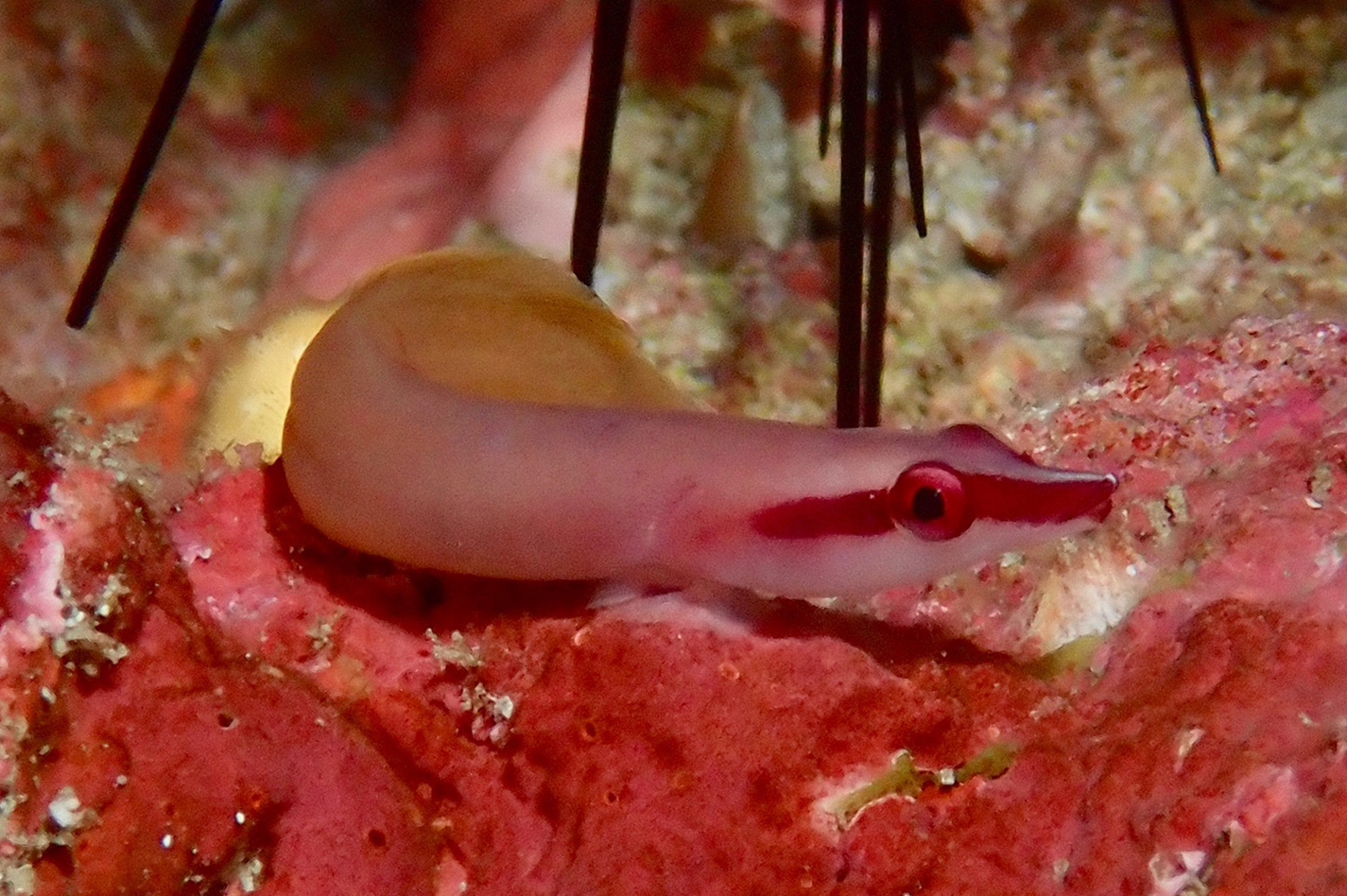Bridled Clingfish, Lepadichthys frenatus Waite 1904
Other Names: Bridled Cling-fish

A Bridled Clingfish, Lepadichthys frenatus, off Malabar, Lord Howe Island, February 2019. Source: jeyre / iNaturalist.org. License: CC By Attribution-NonCommercial
Summary:
A pale greyish, pinkish or orange clingfish with a dark reddish to blackish stripe from the snout through the eye to the rear of the head. Bridled Clingfish usually shelter at the base of large sea urchins.
Cite this page as:
Bray, D.J. 2023, Lepadichthys frenatus in Fishes of Australia, accessed 27 Apr 2024, https://fishesofaustralia.net.au/Home/species/1157
Bridled Clingfish, Lepadichthys frenatus Waite 1904
More Info
|
Distribution |
Southern Great Barrier Reef, Queensland, to at least South Solitary Island, New South Wales; also the Lord Howe Province, and Norfolk Island in the Tasman Sea. Elsewhere, the species occurs in the tropical, west Pacific: New Caledonia, Vanuatu, Fiji and Tonga. Inhabits coral and rocky reefs, often sheltering at the base of the sea urchins Diadema setosum and Centrostephanus. |
|
Features |
Dorsal fin 14-17; Anal fin 12-14; Pectoral fin 27-29; . Gill rakers 11-14. Body slender, cylindrical, compressed at caudal peduncle. Head moderate in width, 15.4–19.8% SL, depressed anteriorly; snout moderate, length 8.7–11.7 in SL, tip slightly rounded (bluntly pointed) in lateral view, duck-beak shaped in dorsal view; dorsal profile of snout slightly concave anteriorly; nasal canal pore usually located before posterior nostril anterior margin. Mouth terminal; upper jaw slightly longer than lower jaw, anterior tip of upper jaw extending beyond that of lower jaw; rear tips of both jaws horizontally level with lower margin of eye. Upper end of gill membrane level with base of 6th to 8th pectoral-fin ray in lateral view. Disc moderate in size, length 15.1–18.4% SL; lower 10th to 12th (11th) pectoral-fin ray base attached to disc base by membrane. Dorsal, anal and caudal fins connected by membranes; upper end of gill membrane level with 6th to 8th pectoral-fin ray base in lateral view; lower 10th to 12th pectoral-fin ray base attached to disc base by membrane. |
|
Remarks |
The Shark Bay Clingfish, Lepadichthys sandaracatus, may be a junior synonym of L. frenatus. |
|
Etymology |
The specific name is from the Latin frenatus (= bridled) in reference to the broad stripe on the side of the head. |
|
Species Citation |
Lepadichthys frenatus Waite 1904. Rec. Aust. Mus. 5(3): 180, pl. 24(2). Type locality: Lord Howe Island. |
|
Author |
Bray, D.J. 2023 |
|
Resources |
Bridled Clingfish, Lepadichthys frenatus Waite 1904
References
Allen, G.R., Hoese, D.F., Paxton, J.R., Randall, J.E., Russell, B.C., Starck, W.A., Talbot, F.H. & Whitley, G.P. 1976. Annotated checklist of the fishes of Lord Howe Island. Records of the Australian Museum 30(15): 365-454 figs 1-2
Briggs, J.C. & Link, G. 1963. New clingfishes of the genus Lepadichthys from the northern Indian Ocean and Red Sea (Pisces, Gobiesocidae). Senckenb. Biol. 44(2): 101-105.
Conway, K.W., Stewart, A.L. & Summers, A.P. 2018. A new genus and species of clingfish from the Rangitāhua Kermadec Islands of New Zealand (Teleostei, Gobiesocidae). ZooKeys 786: 75-104. https://doi.org/10.3897/zookeys.786.28539
Francis, M. 1993. Checklist of the coastal fishes of Lord Howe, Norfolk, and Kermadec Islands, southwest Pacific Ocean. Pacific Science 47(2): 136-170 figs 1-2
Francis, M.P. 2019. Checklist of the coastal fishes of Lord Howe, Norfolk and Kermadec Islands, southwest Pacific Ocean. figshare. Collection. https://doi.org/10.6084/m9.figshare.c.4428305.v2
Fujiwara, K. & Motomura, H. 2019. Validity of Lepadichthys misakius (Tanaka 1908) and redescription of Lepadichthys frenatus Waite 1904 (Gobiesocidae: Diademichthyinae). Zootaxa 4551(3): 275-298 https://doi.org/10.11646/zootaxa.4551.3.2
Gill, A.C. & Reader, S.E. 1992. Fishes. pp. 90-93, 193-228 in Hutchings, P. (ed.) Reef Biology. A Survey of Elizabeth and Middleton Reefs, South Pacific. Canberra : Australian National Parks Vol. 3, Kowari 230 pp.
Johnson, J.W. 2010. Fishes of the Moreton Bay Marine Park and adjacent continental shelf waters, Queensland, Australia. pp. 299-353 in Davie, P.J.F. & Phillips, J.A. Proceedings of the Thirteenth International Marine Biological Workshop, The Marine Fauna and Flora of Moreton Bay. Memoirs of the Queensland Museum 54(3)
Randall, J.E. 2005. Reef and shore fishes of the South Pacific. New Caledonia to Tahiti and the Pitcairn Islands. Honolulu : University of Hawaii Press 707 pp.
Smith-Vaniz, W.F. & Carpenter, K.E. 2016. Lepadichthys frenatus (errata version published in 2017). The IUCN Red List of Threatened Species 2016: e.T67905515A115448665. http://dx.doi.org/10.2305/IUCN.UK.2016-3.RLTS.T67905515A67906425.en. Downloaded on 13 December 2018.
Waite, E.R. 1904. Additions to the fish-fauna of Lord Howe Island. No. 4. Records of the Australian Museum 5(3): 135-186 fig. 32 pls 17-24 https://doi.org/10.3853/j.0067-1975.5.1904.1053




